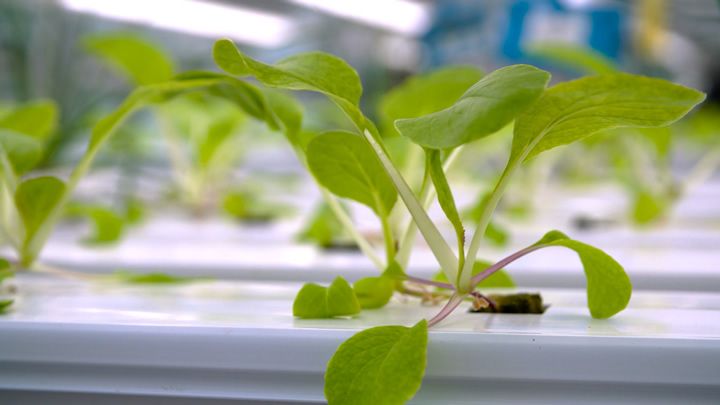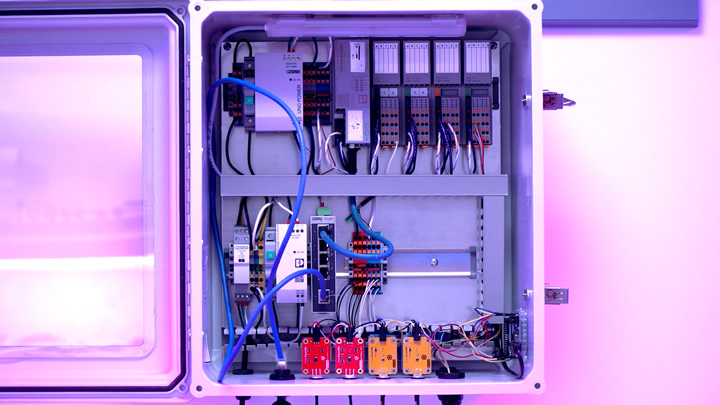Developments in science and technology have enabled farmers to produce more and more, but today's food producers face many challenges: unpredictable weather, irrigation issues, soil degradation, and pollution.
 Growing Tomorrow: Reducing Hunger through Controlled Environment Agriculture
Growing Tomorrow: Reducing Hunger through Controlled Environment Agriculture

Case Study from | Phoenix Contact
With amber waves of grain and stretches of fruited plains, the US is often referred to as the breadbasket of the world. In 2023 alone, US agriculture produced nearly 667 million tons of crops. That's enough to feed around 119 million households.
Developments in science and technology have enabled farmers to produce more and more, but today's food producers face many challenges: unpredictable weather, irrigation issues, soil degradation, and pollution. Populations continue to expand with more mouths to feed (the United Nations projects that by 2050, global food production must increase by 70% to feed an estimated 9.1 billion people), while at the same time, farms are farther from local access. This contributes to one of our biggest crises: the health and food accessibility of many living in "food deserts" (Figure 1).
The US Department of Agriculture (USDA) defines food deserts as "areas where people have limited access to a variety of healthy and affordable food." In urban areas, this would be a population more than 1 mile from a supermarket or more than 10 miles in rural areas. According to the USDA, approximately 23.5 million Americans live in food deserts. (Characteristics and Influential Factors of Food Deserts - Summary)
Technology can transform food deserts into food oases
The Harrisburg University of Science and Technology (HU) Aquaponics Research Greenhouse, located in the food desert community of Steelton, Pennsylvania, is actively working to answer many of the issues faced by today's farms. The greenhouse is a living laboratory where HU students work in teams to gain authentic hands-on experience and develop skills to prepare them for success in the growing controlled environment agriculture (CEA) industry.
CEA is a term that includes several technology-based agriculture systems, including hydroponics and aquaponics. Rachel Fogle, Ph.D., is an Associate Professor of Biological Sciences at HU and the Director of Aquaponic & Hydroponic Initiatives. She defined some of the different technologies that fall under CEA: "Hydroponics is soilless growing. It uses water that's been supplemented with fertilizer based on what you're trying to grow. Aquaculture is fish-raising. Aquaponics combines hydroponics and aquaculture, so it uses the nutrient-rich waste coming from the fish to support plant growth" (Figure 2A and 2B).
Joseph Tetreault, M.S., is a CEA Research Scientist at HU. "The plants get exactly the type of nutrients that they need, whether it's lettuce or a tomato or something else. We don't have to worry about soil erosion or degradation, which is a constant battle for outdoor soil-based farming."
"The students can ask questions, compare fertilization methods, look at the economics that go into controlled growing, or look at the integration of sensors into a bioreactor so that we can monitor and respond in a timely manner," Rachel said.
Hydroponic and aquaponic systems provide high-quality food and can improve yields to feed large populations in small areas. They can present a food production system without pollution or runoff, conserving resources with the ability to recycle water and have it go directly where it is needed. Nutrients from the treated fish culture water further supplement the plants. Integrated pest management plans utilize beneficial organisms as a natural and sustainable method of controlling pest populations; this biological approach reduces reliance on chemical pesticides, promoting a healthier ecosystem and long-term pest resistance management. Nearly everything in the system can be regulated, keeping waste extremely low.
"CEA opens up the possibility for season-independent and location-independent growing," said Rachel. "In an area like Central Pennsylvania, where we can't grow year-round due to winter weather, we can now grow in an indoor space under controlled conditions. This means we can provide food access year-round."
But these systems are not without obstacles. Initial setup can be costly, and some crops do not adapt well to growth in hydroponic systems. Daily operational costs can add up as well, with environmental impact from electricity used in temperature control, lighting, and water pumping. Technicians must also closely regulate a variety of parameters to ensure the system's success.
Rachel explained, "One of the biggest challenges in hydroponics and aquaponics is all of the parts that are connected to one another. We have a lot of pumps in the system. Valves are controlling water rates and water flow. Everything needs to be done so that we have the right water retention times within the space. This ensures the plants have sufficient time to uptake the nutrients they need."
Automation unlocks potential
Glenn Williams, Instructor of Advanced Manufacturing, Augmented Reality (AR), and Robotics at HU, came across the demonstration aquaponics lab in the HU Student Union Center. Glenn recalled, "I liked the idea that they were growing food, and I was interested in how they manually do it. But I felt the information that they needed to advance their research and theories was incomplete. If you're a scientist trying to tweak the aquaponics system, but you're relying on sparse data, it's tough to do the 'what-ifs.'"
Automation presents a key to unlocking the potential of hydroponic and aquaponic systems. With the right technology, these systems can be set up for automated testing, watering, and pumping (Figure 3).
"If we were to automate the monitoring of different aspects of that system, that data could make itself available to the scientists, including the student scientists," he explained. "They could then make better decisions based on what's happening in the Student Union aquaponics."
Automation also led to collaboration between the university's Environmental Science & Sustainability and Advanced Manufacturing programs.
"The student scientists would provide the parameters for the information being processed, and the automation students would provide the ability to get that data, massage it, and then display it in a way that makes sense to the scientists," Glenn said.
To support the control system, HU turned to Phoenix Contact, an automation manufacturer with a US headquarters in nearby Middletown, Pennsylvania. Josh Krug, a Solutions Engineer at Phoenix Contact, provided technical support.
Josh helped the staff and students specify the hardware needed to monitor the CEA system. He added, "I provided examples about how to communicate between the various sensors and other microcontrollers involved, and I also walked them through the math that ties into the software at the end."

The HU greenhouse is automating some of its systems so student scientists can make better decisions for the health of the plants and fish they are growing. Automation also encourages collaboration between students in the biology and advanced manufacturing programs.
Community impact
The greenhouse provides hands-on learning not only to HU students, but also to students from Steelton-Highspire High School. The greenhouse is located on the school district's grounds. But the greenhouse's benefits to the community go beyond that.
"Harrisburg and both boroughs of Steelton and Highspire are considered food deserts by the USDA," Joseph explained. "So, everything that we grow, from the lettuce, tomatoes, cucumbers, and even to the fish, goes back into the community."
Glenn agreed: "It's rooted in giving back. If students realize that their skills and energy are useful to support themselves, their community, and their society, then it is a long-lasting motivational gift."
Downtown Daily Bread, a resource center that supports hungry and homeless individuals in nearby Harrisburg, is the primary recipient of the greenhouse's fish and produce.
On an average day, Downtown Daily Bread serves meals to 260 people. The center is committed to offering fresh, healthy options to its visitors, and that would not be possible without donations from HU's greenhouse, local community gardens, and area food banks (Figure 4).
According to Corrie Lingenfelter, Executive Director at Downtown Daily Bread, nutrition is central to the shelter's meal program: "We emphasize healthy foods, making sure we have our healthy fats, good starches and proteins, and fresh produce. Many of the people we're serving don't get to regular doctor's appointments. They might have high blood pressure or diabetes. That is why it's so important for the overall nutrition, because we may be the only meal they eat that day."
A lifeline for food deserts
Traditional agriculture is never going away. However, science and technology can take some pressure off farmers, reducing overextension and environmental impact while supplying a lifeline to food desert communities.
"CEA uses a much smaller growing space, so we can put it inside a city, whether that's a warehouse, an abandoned building, a vacant lot, or another business," said Joseph. "Growing closer to a population center can cut down on those miles for easier access to fresh and healthy food."
Rachel explained, "Because of the increasing global population and decreased farmable land, there's a need for innovative ways to provide food to certain populations, especially in urban food deserts. Controlled environment agriculture provides a way to consistently give culturally relevant, diverse, healthy crops to those individuals."
The content & opinions in this article are the author’s and do not necessarily represent the views of AgriTechTomorrow
Comments (0)
This post does not have any comments. Be the first to leave a comment below.
Featured Product

